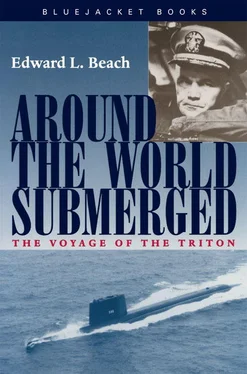“Where does the standard Navy four-hour full-power trial come into this picture?” Pat asked.
“Sometime when we’ve got nothing else to do we’ll run one off just to get it on the record,” I said. “You don’t suppose Admiral Rickover will let Les cut this initial run short of full power, do you—or that four measly hours will satisfy him? Any more than it would satisfy you, if you had to be on board this ship in combat?”
Pat grinned. Then, as we watched the Power Output dial, the needle slowly climbed until it was exactly centered on the full power mark.
“There’s part of the answer, Pat,” I said. “Excuse me, but this I want to see,” and I started aft through the watertight door into the engine room, leaving a Reactor Control Officer staring with delight at the evidence his monitoring instruments were presenting.
In number one engine room, George Troffer had the EOOW watch. Les Kelly was standing right behind him, and Admiral Rickover was seated on a tool chest a few feet away, absorbed in a red-covered book which I took to be a power plant testing manual of some sort. With a side glance at the Admiral, who showed no sign that he had noticed my appearance, I addressed myself to Kelly. “Les, how much power are you indicating back here?” I asked. I had to shout to be heard above the powerful roar of the engine.
Kelly put his mouth to my ear and shouted back, “We’ve just gone to a hundred percent power! She’s running like a million bucks! No trouble at all!”
I decided against asking why I had not been consulted before the speed change was made. No doubt a messenger was off looking for me at that very minute. This was Vice-Admiral Rickover’s plant and his test. My duties, clearly stated for these first trials, were to operate the ship in accordance with his directives. Besides, I, too, wanted to find out what were the actual limitations of our engines.
Les had something more to say, which he did with a broad smile. “One more thing. That’s no power plant manual the Old Man’s got his nose into. Take a good look at the name on the cover, if you get a chance.”
Casting a quick glance at Rickover, who appeared still engrossed in the book with the red cover, I decided to get a better look at it soon, nodded my thanks to Kelly, and began a tour of the remaining engineering spaces.
In number two plant, all was serene. The port engine and reduction gears were spinning away with the greatest aplomb, and every bearing was cool, every critical point reading well within the specified limits.
Lieutenant Curtis Shellman, Machinery Division Officer and presently in charge of the port engine-room watch, must have been born with the sallow complexion and dark circles under his eyes which made his normal everyday appearance that of a man under severe strain; recently he had had every right to look this way, for the main brunt of getting Triton ’s engines ready for her first engineering trials had fallen upon him. Practically all of the operating machinery of the ship was under his surveillance, and the toll of many sleepless hours showed in the veritable death’s head smile he gave me by way of salutation. But there was nothing beaten down or tired about the pure and happy sense of accomplishment which showed there too, as he called my attention to the pounds of steam flow per hour, the throttle setting, the steam pressure, and the effortless RPM of the port main shaft.
Not ordinarily given to use of the superlative, Curt essayed one this time. “She’s just wonderful, Captain!” he yelled. “I’ve never seen an engine run as smoothly as this one. Why, we could take her anywhere, anytime!” His enthusiasm was contagious, and there were corroborating nods from Chief Electrician’s Mates “L” “E” Poe (another old shipmate) and Walter O’Dell, members of the watch section.
It was not hard to believe. What was difficult to appreciate was that Triton at this moment was driving through the water at a speed which no member of her crew had ever experienced, which we would have dismissed as insane had anyone suggested it but a few years ago, which, had this ship but come a few years sooner, might have won the war in the Pacific for us in a matter of months, instead of the years it took.
During this time, Admiral Rickover seemed completely engrossed in his book. He rarely looked up, never changed his position, acknowledged with a brief nod Les Kelly’s shouted reports of the progress of the various tests which were being runoff.
One of the axioms of building a power plant is that all its components must be designed with a large safety factor, for one never knows just which component, or combination of components, will prove to be the weakest element in the chain, and thus limit the power. In the Navy, Admiral Rickover’s nuclear plants were already famous for exceptional dependability. It was soon evident that the Admiral was of a mind to maintain that reputation insofar as Triton ’s two-reactor plant was concerned. This was, at least, the only interpretation I could place upon his reaction to the trouble which shortly afterward developed in our starboard spring bearing.
Since Triton ’s starboard propeller is driven by the forward engine, it follows that the starboard propeller shaft must be much the longer of the two. About midway in its length, its great weight had necessitated installation of a “spring bearing”—merely a line or support bearing to keep it turning true—and it was here, in the most ordinary of standard mechanisms, that the evil little god of misfortune had decreed that difficulty should develop. The first sign of trouble was a rise in the lubricating oil temperature.
Ordinarily, when in receipt of such a report, the immediate thing to do is slow down; but since the initial sea trials were being run by Admiral Rickover, I first sought him out to see what he desired. His red-bound book lay closed on the tool box by the de-aerating feed tank, and I found him down in the lower level of number two auxiliary machinery compartment, where the offending spring bearing was located high in the starboard after corner. When I arrived, the entire group of designers and engineers aboard for the trials were already present; and the gray-haired birdlike Admiral had climbed up into the corner for a close inspection, squeezing his wiry frame into the cramped space between the swiftly rotating propeller shaft and the curved hull of the ship, alongside the huge steel box containing the bearing.
“We’re going to have to cut the power, Ned,” said one of the bystanders, an Electric Boat supervisor. “It’s too bad, but we can’t take a chance on wiping this bearing.”
This was the evaluation I sensed from everyone present. The decision, however, was Rickover’s, as the officer responsible for the initial sea trials. He had evidently been listening to the bearing with a large screwdriver held against his head, and I got there just as Les Kelly handed up a stethoscope taken from one of our repair kits.
Long minutes passed while Rickover listened at various spots on the bearing housing. There was a grim set to his jaw when he descended at last from his perch alongside the housing. “There’s not a thing wrong with the bearing,” he said shortly. “It’s working exactly as designed, but it’s not designed right.”
“We’ve already proved the designed power of the ship, Admiral,” said the Electric Boat representative who had spoken with me. “We’ll get right on the bearing as soon as we get back to the Boat Division. I’m sure our designers can figure out what’s wrong….”
“The only thing wrong is that it needs more cooling. Any fool can see that,” cut in Rickover. “Besides, we’re not going back. Not yet—Kelly!” Abruptly he shifted his attention to Triton ’s Chief Engineer. “Rig a hose. Get a constant spray of water going on the bearing housing. Set a special watch on the lube oil temperature!”
Читать дальше












